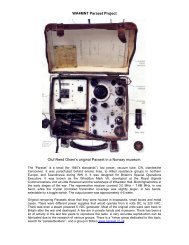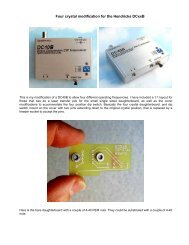Small Magnetic Loop Antenna Project - QRPBuilder.com
Small Magnetic Loop Antenna Project - QRPBuilder.com
Small Magnetic Loop Antenna Project - QRPBuilder.com
Create successful ePaper yourself
Turn your PDF publications into a flip-book with our unique Google optimized e-Paper software.
unning relatively low duty cycle SSB voice modes / PEP transmissions. All is OK with<br />
vacuum capacitors as long as the rated glass/ metal seal temperature is not exceeded. This<br />
is unlikely to occur in practice as the silver plated copper mounting clamps efficiently<br />
heatsink and remove any heat into the copper loop conductor.<br />
Mono-band loop operation yields the best result as the optimum loop inductance to<br />
capacitance ratio can be chosen and the majority of the tuning capacitance can be provided<br />
with a fixed vacuum capacitor. A much smaller vacuum variable capacitor can then be<br />
deployed in parallel to achieve fine vernier “bandspread” tuning across the whole band of<br />
interest, e.g. 40m or 80m, etc.<br />
Top-band operation at 1.8 MHz is always the hardest challenge for any antenna type, small<br />
loops (typical dimensions of 0.02λ) included; but their on-air performance can nevertheless<br />
be authoritative with a <strong>com</strong>manding signal presence. There are no "free lunches" (and few<br />
cheap ones) when shrinking the size of antennas as the free space wavelength has not yet<br />
been miniaturized by nature redefining the laws of physics! Consequently antennas of<br />
such diminutive size must always be placed into proper perspective when <strong>com</strong>pared with<br />
the performance attainable from a full-sized λ/2 horizontal dipole for 160m. However,<br />
most amateurs haven’t got sufficient residential block size and/or mast height in a fraction<br />
of wavelength to ac<strong>com</strong>modate a 160m dipole that works properly with a decent radiation<br />
efficiency and ability to put its radiated power in a useful direction. Similarly, reasonably<br />
efficient and efficacious Verticals for 160m operation unfortunately exceed the allowed<br />
height by a great margin that’s permitted by local council and residential building code<br />
regulations. Then a huge amount of real estate is required to ac<strong>com</strong>modate the extensive<br />
radial system.<br />
The practical on-air performance of a loop on the 160/80m bands will be highly dependent<br />
on what antenna you use as a reference <strong>com</strong>parison, e.g. a centre-loaded mobile whip or<br />
full size resonant dipole/monopole, etc. and what path is used, NVIS, ground wave, sky<br />
wave, etc. The loop conductor diameter is determined by the desired loss resistance due to<br />
skin-effect, and choices can range from modest 6mm copper tubing to large bore 100mm<br />
copper or aluminium tube. Commonly used conductor diameters used to construct a<br />
magnetic loop are 20mm and 32mm soft copper tube. Heavy wall thickness tubing is not<br />
required as the RF current flow is confined to the conductor surface due to the skin-effect.<br />
Note that the radiation efficiency is not related to the loop size. <strong>Loop</strong> antenna efficiency is<br />
determined by the conductor tube diameter and its conductivity. This conceptual notion is<br />
counterintuitive for many folks. A small loop will also be efficient and radiate power very<br />
effectively on 80m and 160m but the resultant L–C ratio and stored energy will often be<br />
such that the loop’s Q factor will be so high as to yield an impractically small<br />
instantaneous bandwidth that’s not useful for SSB <strong>com</strong>munication purposes. Achievable<br />
bandwidth is roughly proportional to loop size / diameter and Q is inversely proportional to<br />
the loop diameter. Depending on its construction a small loop of nominal 1m diameter can<br />
exhibit an intrinsic radiation efficiency of 90% over the 1.8 to 30 MHz frequency range.<br />
Copper tubing is the preferred material to fabricate the loop as it has a higher conductivity<br />
than aluminium.<br />
Larger size semi-rigid Heliax coax such as LDF550 / LDF650 / LDF750 will conveniently<br />
make excellent loop construction material for the smaller diameter 20m to 10m HF band<br />
loops when run at the 100 to 400 Watt power level.<br />
9





